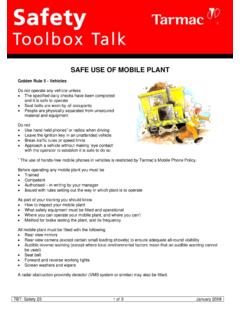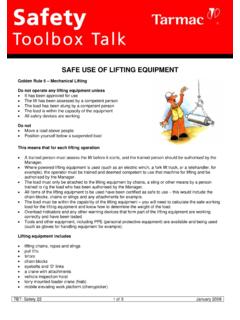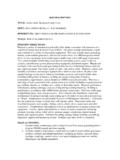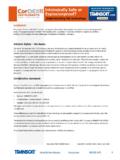Transcription of SAFE USE OF LIFTING EQUIPMENT - safequarry.com
1 TBT: Safety 22 1 of 5 January 2008 safe USE OF LIFTING EQUIPMENT Golden Rule 6 mechanical LIFTING Do not operate any LIFTING EQUIPMENT unless It has been approved for use The lift has been assessed by a competent person The load has been slung by a competent person The load is within the capacity of the EQUIPMENT All safety devices are working Do not Move a load above people Position yourself below a suspended load This means that for each LIFTING operation A trained person must assess the lift before it starts, and the trained person should be authorised by the Manager. Where powered LIFTING EQUIPMENT is used (such as an electric winch, a fork lift truck, or a telehandler, for example), the operator must be trained and deemed competent to use that machine for LIFTING and be authorised by the Manager.
2 The load must only be attached to the LIFTING EQUIPMENT by chains, a sling or other means by a person trained to rig the load who has been authorised by the Manager. All items of the LIFTING EQUIPMENT to be used have been certified as safe to use this would include the chain blocks, chains or slings and any attachments for example. The load must be within the capability of the LIFTING EQUIPMENT you will need to calculate the safe working load for the LIFTING EQUIPMENT and know how to determine the weight of the load. Overload indicators and any other warning devices that form part of the LIFTING EQUIPMENT are working correctly and have been tested.
3 Tools and other EQUIPMENT , including PPE (personal protective EQUIPMENT ) are available and being used (such as gloves for handling EQUIPMENT for example). LIFTING EQUIPMENT includes LIFTING chains, ropes and slings pull lifts tirfors chain blocks eyebolts and D links a crane with attachments vehicle inspection hoist lorry mounted loader crane (hiab) mobile elevating work platform (cherrypicker). TBT: Safety 22 2 of 5 January 2008 It also includes vacuum LIFTING cranes passenger material lifts plus many more items. Failure of LIFTING EQUIPMENT can result in serious or fatal injury.
4 Inspection of LIFTING EQUIPMENT All LIFTING EQUIPMENT must be regularly inspected by a competent authority. Tarmac currently uses a specialist company - Bureau Veritas - at most sites. The testing intervals are: LIFTING EQUIPMENT not used for LIFTING persons 12 months LIFTING EQUIPMENT used for LIFTING persons or preventing a person falling 6 months. However each time you use LIFTING EQUIPMENT you should visually inspect it for defects. If any are found then the EQUIPMENT must be clearly marked as defective, quarantined and taken out of use. Things to check when inspecting LIFTING EQUIPMENT Elongation or stretch of chains (you can determine this by choking the chain back on itself so that the mid-point hangs down.)
5 Line up the links at the top on both sides: the links should match throughout the length. If they don t, the chain has been stretched. You will need to determine the maximum permissible stretch for the chain). Wear on the links the strength of the chain can be severely compromised by significant wear. If wear is noted the chain should not be used and should be quarantined for further inspection by a competent person. Chain hooks must be free from distortion, stretch or twist. For multi-leg chains the ring should be free from distortion. If this is apparent then the chain should not be used (example in the photograph).
6 Webbing slings can suffer abrasion, cuts and tears and chemical degradation. Regular close inspection is essential to avoid using damaged or defective slings. Damaged slings must be discarded as they cannot be repaired. Pull lifts and chain blocks are free from damage chains are sound and hooks are straight and free from distortion. Additionally, to prevent the risk of injury, LIFTING EQUIPMENT that you use must be: suitable for the purpose attached to a suitable LIFTING point. TBT: Safety 22 3 of 5 January 2008 Chain hooks used for a lift must be fitted with a spring-loaded safety catch, or designed to prevent the load disengaging C hook (diagram to the left).
7 Multi-leg chains are commonly used to lift the load. Never use a double-legged chain as a single leg with the load suspended from the single leg (photograph right). When using a four-leg chain, the safe working load should be calculated using three legs only, as the fourth typically does not become loaded. Angle between chains For all multi-leg chains the angle between the chain legs is critical the greater the angle, the greater the safe working load of the chain to lift a given load. For example, to lift a load of 450kg using a two-leg chain, the SWL of each leg at an angle of 30o is 240kg, but if you increase the angle to 120o, the SWL increases to 450kg for each leg.
8 This is shown in the accompanying diagram. Undertaking the lift The lift must always be planned. Setting up the lift You need to know the weight of the EQUIPMENT being handled. The safe working load of the LIFTING EQUIPMENT being used must be adequate for the task. Are the LIFTING /slinging points adequate or will additional work be necessary to provide a LIFTING beam of adequate strength? Never use non-structural steelwork in a building. Can the LIFTING EQUIPMENT be used safely is the load likely to swing or fly when released? Is the LIFTING EQUIPMENT free from damage or distortion?
9 Completing the lift Golden Rule 6 Do not move a load above people Do not position yourself below a suspended load If the load needs to be controlled, never hold the load while being slung - use a dog rope or tag line. Hooks used for LIFTING must be fitted with a safety catch, moused or shaped to prevent the sling eye or load coming off the hook. TBT: Safety 22 4 of 5 January 2008 When using multi-leg slings ensure that the angles of slings are no more than 90o wherever possible. Ensure the slings being used are the correct ones for the job the majority of accidents associated with LIFTING EQUIPMENT are caused by faulty slinging, such as overloading or an unbalanced load which results in the load falling or tipping out of control.
10 If wire rope slings are being used, ensure sharp corners are protected. Remember doubling up slings does not double up the safe working load. This is poor practice and should be avoided. Ensure that any unused leg of a multi-sling is correctly hooked back. Ensure the load is free before LIFTING , and that all legs have a direct load never snatch a load. QUESTIONS (there may be more than one correct answer) A B C 1 Who can operate LIFTING EQUIPMENT ? A person who has previous experience in LIFTING operations A person trained, deemed competent and authorised A trained person 2 What type of items of LIFTING EQUIPMENT can be used?
















